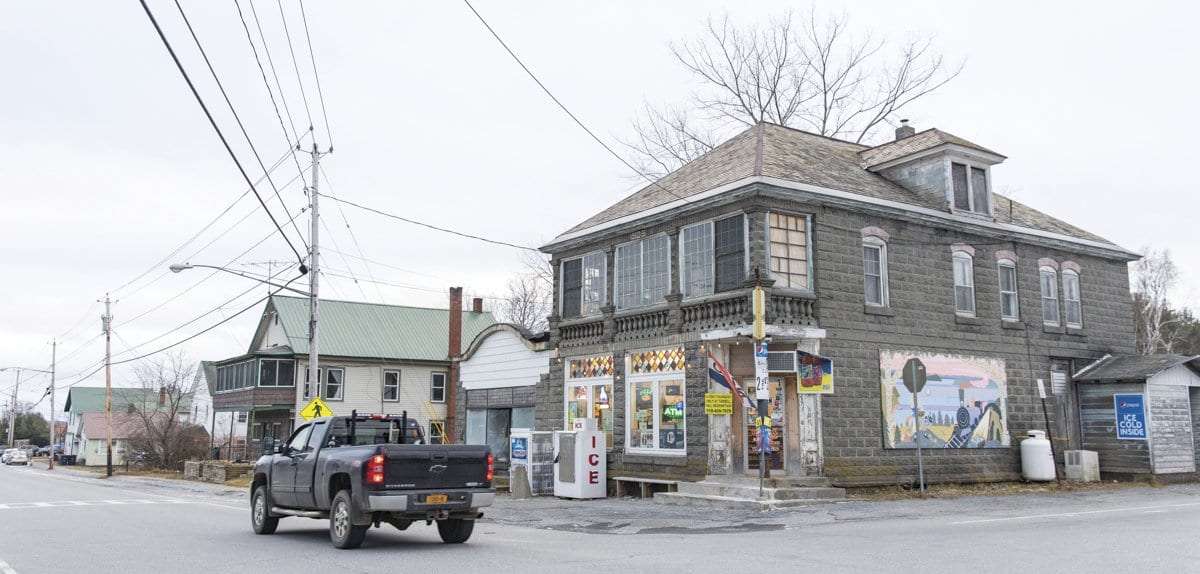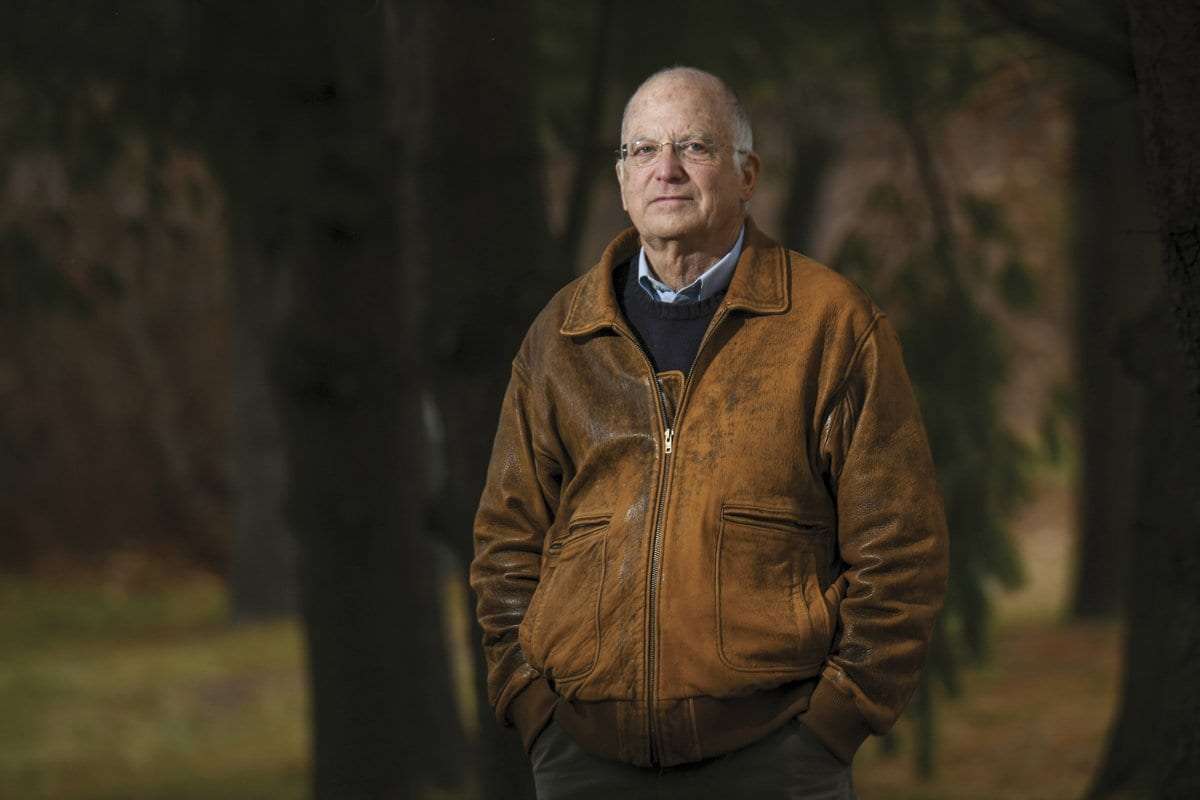Biologists fear Moriah clean-energy project
threatens endangered species
By Ry Rivard
In the five years before the iron mine closed for good in 1930, miners hauled 400,000 tons of the world’s finest ore out of Barton Hill. When they left to mine in other Adirondack mountains nearby, Barton Hill’s gutted innards went quiet, got dark and filled with bats.
Tens of thousands of bats.
The conditions inside the closed mine, its long passages still flowing with air, were perfect for hibernating bats, which need a safe place to hang helpless through long Adirondack winters. Even when a strange fungus crept across the ocean and began killing most of New York’s bats, the bats in the Barton Hill Mine fared better than most.
The old mine, in the Town of Moriah near the shores of Lake Champlain, is now one of the most important refuges for bats in North America. The Barton Hill hibernaculum, as it’s known, is a winter home to some 50,000 bats, including one of the largest populations of endangered Indiana bats outside of the Midwest. There are more bats in the mine than almost anywhere else in the Northeast.
They may now all be in peril.
Bats vs ‘batteries’
Just down the hill, a developer is looking to reopen a pair of mines that closed in the 1970s to create a new hydroelectricity project
The $300 million project, in effect a giant water battery, would use massive subterranean passages to create electricity by pumping water up and down.
Known as the Mineville Energy Storage Project, this could provide energy free of fossil fuels to parts of the North Country. It’s also a rare economic development opportunity for this corner of the state.
But federal regulators have taken a dim view of the project because of what it might do to the environment and the bats.
Building the power project would require months of blasting, drilling and construction in an area connected below the surface to the hibernaculum. And operating it would require millions of gallons of water to slosh back and forth underground less than a mile from Barton Hill.
All this could forever alter the subterranean conditions—a near-perfect mix of temperature and humidity—that have made Barton Hill a safe haven for so many bats.

Six species of bats hibernate there, most of them in danger of going extinct. Indiana bats were among the first animals federally listed as an extinction risk, in 1967. There are more than 12,000 Indiana bats in Barton Hill. Three other species found in the mine—little brown bats, northern long-eared bats and tri-colored bats—are either already on the endangered list or soon could be.
Kate Langwig, a Virginia Tech professor who started her career in New York and has studied Barton Hill bats, said the sprawling old mine has a variety of temperatures and humidity conditions, making different parts of it ideal for different species. Together in one place, these microclimates create a hibernating spot that is unlike anything else she’s aware of in the eastern part of the country.
“Modifying that in any way is absolutely not going to be good for the bats.”
— Kate Langwig, Virginia Tech professor

The project’s beginnings
The energy storage project is the brainchild of Jim Besha, the CEO of Albany Engineering Corp.
Besha has spent 30 years working on the project, which, if not one-of-a-kind, is probably the largest of its kind.
The project got started back in 1990, when Niagara Mohawk Power Corp. wanted a new way to generate power in the North Country without facing the bureaucratic hurdles other projects have encountered inside the Adirondack Park.
Besha’s big idea won’t actually generate new power but it takes an old technology known as “pumped storage” and buries it. He would build what amounts to a giant battery in a massive underground mining complex that holds two mines, known as the Old Bed and Harmony mines. Because one mine is hundreds of feet above the other, they can generate hydroelectric power underground, using gravity.
Since Republic Steel Co. shut the mines down in the 1970s, 4 billion gallons of water have seeped into the mines, so there’s already water there, ready to use.
Hydroelectricity comes from an astonishingly simple fact. As water moves, particularly as it falls, it can spin machines known as turbines to generate power.
At some hydroelectric dams, power can be made on demand. Rivers will be bottled up in a reservoir and then released when energy is needed.
In the Adirondacks, though, dam operators face restrictions on how much water they can hold back, in part because their dams are small and in part because environmental regulators want to keep rivers flowing if possible. That means hydropower isn’t always available when people need it most. Now that coal and gas are being sidelined to fight climate change, there is a scramble to figure out how to store wind, solar and hydropower.
Pumped storage does that.
The Mineville project would buy power when it’s not needed and is therefore cheapest, say $40 per megawatt hour, and would use that electricity to pump water from the lower mine to the upper mine.
When electricity prices rise, it would release water from the upper mine back down to the lower mine. As the water falls it would generate electricity that could be sold at, say, $80 per megawatt hour.
Normal pumped storage projects are a nightmare to permit when they’re done above ground. They involve the construction of a new dam and reservoirs, which flood massive areas. Despite rising demand for energy storage, there are only about 40 pumped storage projects in the U.S., and most of them were approved decades ago.
Doing everything underground in an area that has already been mined is an elegant solution that avoids all sorts of destruction and permitting hassle.
If Besha gets the permits, there’s already a company, Hull Street Energy, that will put up the money to build the project, as well as another similar project that he has planned for Lyon Mountain.
The Mineville project would be one of the few big developments in the area since the mines closed. Once it’s built, a project like this can run without much staff, but it would certainly boost the local property tax collections.
“It’s almost a perfect location,” Besha said.
At least it seemed to be.
Years of bat population decline
In 2006, the first signs of what’s now known as white-nose syndrome were spotted on bats from a cave near Albany.
Across the Northeast, researchers began finding dead bats lying in white snow, tipping them off to a catastrophe in the making. A deadly fungus had traveled from overseas and now it was here.
While bats have a loathsome reputation as nighttime terrors, they’re sewn into the fabric of our world. Researchers have found that bats contribute as much as $50 billion a year to the American farming economy by eating insects, which reduces the need for pesticides. A single group of 100 bats might eat millions of bugs in a single season.
The bats weren’t ready for the new disease, which attacks them while they hibernate. During hibernation, bats’ body temperature drops to about the temperature of their surroundings. Bats save just enough energy to wake a few times from hibernation to fly around to get water or change spots. Waking up too often can be fatal.

More about bats
Here is more reading on bats, from the Adirondack Explorer and Adirondack Almanack archives:
- Bats’ survival at stake (From 2011, about white nose syndrome’s impact)
- Help protect bats: A primer (An overview of Adirondack bat species)
- Little and big brown bats (Part of a series about Adirondack bats)
- Our vanishing bats (From 2010, an interview with biologist Al Hicks)
(Photo courtesy of DEC)
White-nose syndrome causes them to expend precious energy to wake up more often and fly around. They lose too much water and the food they have stored up. Then they die.
First they died by the thousands. Then they died by the millions.
The U.S. Fish and Wildlife Service calls the bat fungus one of the worst wildlife diseases in modern times. White-nose syndrome has spread to some 30 states and seven Canadian provinces, killing 90 percent of the hibernating bats in those places.
The disease has killed more than a million bats in New York alone, said Carl Herzog, the state Department of Environmental Conservation’s top biologist.
There’s at least one place in the Northeast, though, where conditions seem to be good for bats but not so good for the fungus. It’s the Barton Hill Mine.
“The bats in the Barton Hill mine, however, are doing much better in the face of the disease than any other hibernation site that we know of in New York,” Herzog said in an email. “As a result it is, without exaggeration, the most important bat hibernation site in the region.”
Indiana bats, for instance, like humid places with stable temperatures, under 50 degrees but above freezing. The fungus thrives in a nearly overlapping zone of 40 to 50 degrees and humid.
But Langwig, the professor, said Barton Hill provides a “Goldilocks zone” for bats—too cold and dry for the fungus to grow quickly but not too cold or dry for bats to hibernate.
Anything that disrupts the delicate balance—the explosions to excavate the mine, closing or opening subterranean caverns, even slight changes in conditions caused by all the moving water—might cause changes that imperil the bats.
Even though Barton Hill is several thousand feet away from where the hydroelectric project would be, the nearby mines are connected in unexpected ways. There is at least one tunnel between Barton Hill and the mines where the hydroelectric project will be, a passageway 3,000 feet below the ground.
Besha, the developer, plans to drill down and seal off the passage to ensure that nothing he does can change what happens at Barton Hill.
“The project, we believe, will have no direct effect on bats,” he said.
But there are a lot of unknowns. Though biologists have been inside Barton Hill and know it’s perfect for bats, nobody has been inside the other two old mines for years—they’re closed and filled with water
Besha focuses on the knowns. He has boxes and boxes of diagrams and documents about the mines, including former Republic Steel engineer Patrick Farrell’s detailed book on Mineville, “Through the Light Hole,” which Besha said he has read 100 times. He thinks he knows what to expect down there.
Regulators worry he doesn’t, and that nobody does. Their focus, on the unknowns, is at very least holding up permitting of the project.
In a draft environmental impact statement, the Federal Energy Regulatory Commission, known as FERC, said connections between the mine sites are “not well understood,” so construction work “may result in changes to water level, temperature, humidity, and other variables that currently represent suitable conditions for hibernating bats.” Regulators concluded that alterations of those conditions “may result in unavoidable changes.”
If there’s one person in New York who has walked the fine line between development and endangerment, it’s Besha. In the 1980s, he had another run-in with endangered bats while helping build the Glen Park hydroelectric project on the Black River near Watertown.
Then, Besha helped come up with a plan to monitor the bats there before and after blasting began. He put listening devices, an infrared camera, vibration monitors and thermometers into the cave.
A plan for protection
Al Hicks, a former DEC biologist who has studied bats as much as nearly anyone alive and was one of the first biologists to deal with white-nose syndrome, was around then too and tasked with protecting the bats for the state.
“He pulled it off. And that was a very good example of being able to do what you wanted to do. With some minor adjustments and considerations, you can protect the wildlife resource.”
— Al Hicks, former DEC biologist
Now, Hicks is an unpaid adviser to Besha and thinks Besha can do in Mineville what he did in Watertown: build without driving off the bats. Hicks, who has been in the Barton Hill Mine 40 or 50 times, said he hates the idea that people think we can’t have progress and save the environment at the same time.
“I think this project is a low risk,” Hicks said. “And I appreciate the consequence of it blowing up in their faces, but I think the chances of it blowing up in their faces are so small.”
Federal environmental regulators aren’t so sure Besha’s previous success means much, given that the Mineville project is a different project and, because of white-nose syndrome, the stakes are far higher.
Besha said he has an elaborate monitoring plan to make sure the bats in Barton Hill survive. The plan, however, is not public because regulators are concerned it reveals the location and numbers of endangered species. Because the plan is not public, it’s possible some of the people criticizing the project don’t understand everything that goes into it, Besha said.
“I suspect some of those people have not looked at the plan or what is being proposed,” Besha said. “The plan is more detailed than ‘measure and just start doing stuff.’”
But those who have seen the plan also question whether monitoring is enough.
New York environmental regulators called one version of Besha’s monitoring plan “of limited value” because the monitoring might end up showing bad things happening in a way that’s irreversible.
“A protection plan must emphasize avoidance and minimization of impacts, not monitoring and mitigation,” the department wrote several years ago.
Basically, it wouldn’t do much good to have all the cameras and monitors in the world watching the death of endangered bats due to changes in the mine that cannot be undone.
A regional official from the U.S. Department of the Interior, the department that houses the federal Fish and Wildlife Service, wrote in summer 2019 that “it is not clear that the measures will be adequate, implemented properly, or adjusted appropriately if needed.”
In late 2020, Besha ran into a big problem.
In mid-December, as the Explorer went to press, FERC threw out the project’s application because Besha couldn’t get state environmental regulators to sign off. This doesn’t mean the project is dead. Besha, though frustrated by the decision, can still appeal it.
“Is New York State serious about renewable energy and climate change or not?” Besha said. “DEC’s lack of action would seem to indicate it is not.”
The bats, of course, know none of this, even as their population shrinks. For years, bats across the country have been threatened by all kinds of human activity—everything from pesticides that kill the bugs they eat to logging that cuts down the trees they live in during the summer. Their caves have been disturbed by developers and gawkers, including tourists who may have brought white-nose syndrome into America. Even some of the gates that officials put up on caves to keep people away from bats were a problem, since they choked off airflow and harmed the bats they were meant to protect.
In Barton Hill, in one of the last spots they can, thousands of bats rest undisturbed.
When you’re buying electricity for $40 a MW, it’s not fossil fuel free energy unless you guarantee its provided by nuclear, hydro or wind. Otherwise, it’s coal or gas. And really, unless it’s base load for nuclear, it’s wasted energy.
Pumped storage of electricity is a smoke and mirrors false economy. No investment in scaled-up physical plant, except perhaps batteries at point of use, is a smart investment in reality. Only in the false economy of ‘guaranteed return on spending’ utility regulation would this project even be considered by investors.
These “energy storage plants” are incredibly expensive, risky, and never put out but a fraction of the energy they “store”. Pumping water off peak to then run through a generator on peak won’t recover even a fifth of the energy the pumps use to park this water in storage.
What does work–with no real facility or power plant costs–is time of use rates. Let energy users buy off-peak electricity at these super low prices while charging on peak users the true cost of creating usage peaks, and load curves flatten. Manufacturing sectors shift consumption, reducing peak loads.
Even consumer loads are shifted to off peak periods when time of use rates make the price signal clear that choosing to use power at the same high-load time as everyone else costs more than nights or other off peak times. New appliances have timers to shift the washer or dishwasher operating time; hot water heaters can be cycled off during peaks, air conditioning can be limited briefly by load management systems, etc. It’s a proven, low cost approach.
Flooding a mine will kill bats and other life that lives there. It will change the chemistry of the water and groundwater. It will be devastating in it’s effect, and it will waste far more energy than it ever “produces”.
Why not invest in load management, after restructuring electric rates so users see clearly the costs of piling on more peak load, and rewarding customers not just for not using energy, but reward those with lower energy costs that shift consumption off peak. It works, with no ratepayer or utility risk.
This proposed project does nothing to save energy and help the climate. “Smoke and mirrors” as a previous commenter noted. Please do not risk one of the most critical bat hibernaculums in the Northeast.